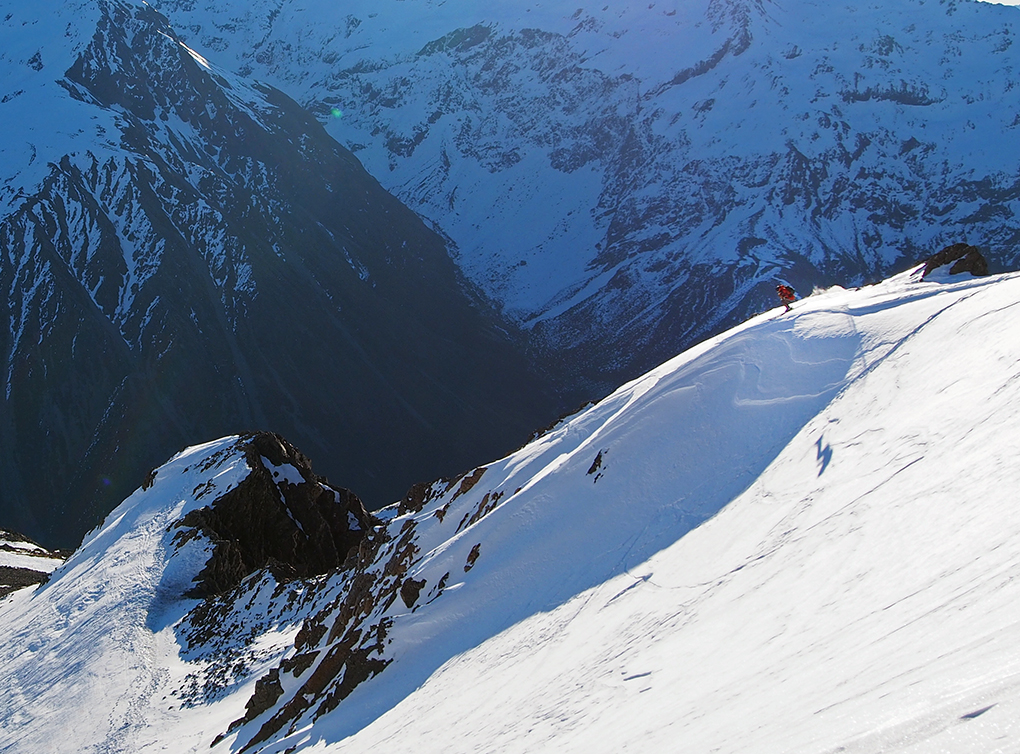Heavy, Spring Slush
In softer, more spring-like conditions at Craigieburn, the Invictus felt smoother and more manageable than it had in the firmer snow at Temple Basin, but still seemed to require strong, assertive turns in the steep, tight chutes above Middle Basin. Here the snow was very wet and heavy, warmed to the point where it could easily be pushed around into piles, somewhat mimicking the tracked up conditions you might see after lunch on a 3-4″ pow day.

The Invictus’ tail is slightly rockered, and this did allow the ski to pivot and smear a bit, though not as immediately as the Cochise’s would have, I think – I had to be ready if I wanted to throw the Invictus sideways quickly. However, part of this may have had to do with the thicker, wet consistency of the snow.
I’m still inclined to characterize the Invictus as slightly heavier, grippier, more demanding Cochise, but I’ll have to test both skis back to back in a wider range of conditions to confirm that. As I mentioned above, in soft conditions with some lighter snow, the Invictus ought to feel a little quicker than it has so far, while perhaps providing more stability than the Cochise at high speeds in open terrain.
Other Remaining Questions / Comparisons
Besides the Cochise, there are obviously a few other very similar skis that I still need to compare the Invictus to directly. So far it reminds me a bit of the previous 2013-2014 Moment Belafonte and I’m curious to see how it compares to the 2014-2015 Belafonte. While my initial feeling, again, is that the Invictus is more substantial than the Cochise, I’m curious to see how closely it matches the new Belafonte and if it holds some qualities the Belafonte doesn’t in this directional, all-moutnain class.
The Invictus also seems to have some important similarities to the new DPS Wailer 105, which I’ll also be putting time on this season. And lastly, the Line Supernatural 108 is, I think, more similar to the Cochise than the Invictus, but I’m curious to find out how much more.
Bottom Line (For Now)
After the four days I’ve spent on the Armada Invictus in a relatively narrow set of variable conditions, one thing is certain: it’s a ski unlike anything Armada has made before. The Invictus isn’t terribly light, or especially playful, and it sits squarely in the same class as some of our favorite all-mountain chargers.
With more days on snow, I’ll gain a better, more comprehensive sense of the ski, but I fully expect that the Invictus will appeal to a lot of people looking for a directional all-mountain ski with a stout, big-mountain feel.
Update
You can now read Jonathan Ellsworth’s 2nd Look at the Armada Invictus, with comparisons to a number of other directional chargers.
Deep Dive: Armada Invictus 108Ti
To get our comparisons of the Invictus 108Ti to nine other directional chargers, and see all of them on a spectrum from ‘most demanding / stable’ to ‘most playful / forgiving,’ see the Blister Deep Dive: Armada Invictus 108Ti.
NEXT: Rocker Profile Pics

I had a chance to ski these last March in Fernie and came to a similar conclusion as you. I was looking for a narrower ski than my bibbys for everyday skiing when the conditions are firm. The Invictus is stable at speed, holds a great edge but is very difficult to break loose. In fact I scared the sh#t out of myself as I came maching down a section and had to make a sharp right turn. I’ve made this turn hundreds of times on the bibbys and on XXls but on the Invictus the tail did not want to release to bleed some speed. If you like to smear your turns this is not the ski for you. I didnt get a chance to detune the tails and try them out again. I am trending toward the Line Supernatural 108.
Any thoughts on mounting these -1, -2? I have the Norwalks and the thing I really notice about the factory mount location is that it gives the ski A LOT of tail. Great for stability through the turn, terrible for trying to bleed some speed.